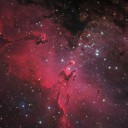DL MARTIN wrote: ↑Fri Nov 15, 2019 9:53 pm
If what we are seeing emanated 7,000 year's ago and we can't account for what's come since, then why not refer to the transmission from then to now as 'DARK LIGHT'?
I remember reading a rather "serious" science fiction novel, where one of the characters, a scientist, said something to the effect that "there is no such thing as 'now' in the Universe".
And that's true. I think I remember some astronauts being interviewed while on the Moon. (I'm pretty sure it was not Apollo 11.) Well, the interviewer, on the Earth, asked a question, and then there was an agonizing circa three seconds' worth of wait before the astronaut answered. Because the interviewer's question had to travel, at the speed of light, to the Moon, which took circa 1.5 seconds, and then the astronaut's answer had to travel back to the Earth, which took another 1.5 seconds. So what is "now" on the Moon? It is not our "now".
Imagine talking to astronauts on Mars. The distance to Mars varies, but we can be sure that it will be at least one light-minute, and it can be a lot more. So a conversation between a person on the Earth and a person on Mars will be constantly interrupted by several minute-long pauses.
What is "now" at the heliopause, where the Voyager spacecraft are currently located? What is "now" at Alpha Centauri, the nearest star outside our Solar System, some four light-years away? Imagine a conversation between a person on a planet of Alpha Centauri and a person on the Earth.
So can we know anything at all about nebulas and galaxies? When we don't know what their "now" is?
Here's the answer. We can have a good idea of what distant nebulas and galaxies are like because we can compare them with so many other, and more nearby, nebulas and galaxies.
Foreground galaxy cluster at 4.6 billion light-years and arc-shaped lensed
galaxy at 11 billion light-years. Edge-on galaxy at 6 o'clock.
ESA/Hubble, NASA, Rivera-Thorsen et al.
Edge-on spiral galaxy NGC 5746 at circa 80 million light-years.
Photo: Göran Nilsson and the Liverpool Telescope.
In the picture of the galaxy cluster at left, look at the two bright blue-white stars at lower right. To the lower left of one of them is an edge-on, yellow spiral galaxy. We can be pretty sure that this galaxy is at least 3 billion light-years away. Can you see that it is incredibly similar to nearby (circa 80 million light-years) edge-on spiral galaxy NGC 5746? My point is that we can see distant objects that are very similar to nearby objects, and by comparing them we can draw conclusions about what they are.
Okay. M16, as in the APOD that this thread is about. This is what
Wikipedia says about it:
The Eagle Nebula is part of a diffuse emission nebula, or H II region, which is catalogued as IC 4703. This region of active current star formation is about 7000 light-years distant.
The cluster associated with the nebula has approximately 8100 stars, which are mostly concentrated in a gap in the molecular cloud to the north-west of the Pillars.
The cluster's age has been estimated to be 1–2 million years.
Evidence from the Spitzer Telescope originally suggested that the pillars in M16 may already have been destroyed by a supernova explosion. Hot gas observed by Spitzer in 2007 suggested that the area was disturbed by a supernova that exploded some 8,000 to 9,000 years ago.
However, in 2014 the Pillars were imaged a second time by Hubble, in both visible light and infrared light.
It was later discovered that there in fact was no supernova explosion within them, and it is estimated they will be around for at least 100,000 years longer.
So some 7,000 years have passed since the light from M16 left its source of origin. During the 7,000 year long journey to the Earth, the nebula itself has certainly changed a little, but not much. The pillars are most likely still there, and the stars have changed hardly at all - unless one of the most massive stars has become unstable.
The real point is that time and space are interconnected and can't be separated from one another. That means that because M16 and the Earth are in different places in space, we can't be in the same place in time. It is impossible.
But astronomers can be detectives and put together huge jig-saw puzzles of the Universe. No, they clearly don't know everything yet, but what they do know is amazing.
And they do have a good handle on M16.
Ann
 M16 and the Eagle Nebula
M16 and the Eagle Nebula

